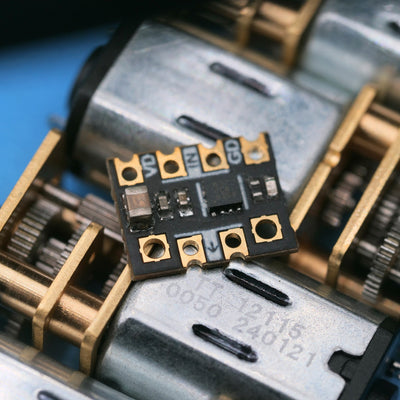-
To initialize the DriveCell, create an instance of the
DriveCellclass by specifying the input pins connected to your motor or actuator, then call theInit()function. Here’s how you can set it up:#include "DriveCell.h" DriveCell myDriveCell(IN1, IN2); // Replace IN1 and IN2 with your specific pins void setup() { myDriveCell.Init(); // Initializes the DriveCell }
Below are the functions provided by the DriveCell library. Basic functions work on all Arduino board + optimized PWM functions for CodeCell & other ESP32 devices
- Function:
Init() - Description: Initializes the DriveCell by setting up the GPIO pins and attaching the necessary timers.
myDriveCell.Init(); // Initializes the device
- Function for ESP32:
Run(bool smooth, uint8_t power_percent, uint16_t flip_speed_ms) - Description for ESP32: Uses PWM and hardware timers to flip the actuator or motor polarity every few milliseconds. The smooth parameter enables smoother transitions.
- Examples:
myDriveCell.Run(true, 50, 500); // Smooth operation at 50% power, flipping every 500 ms
- Function for Other Arduino Devices:
Run(uint16_t flip_speed_ms) - Description for Other Arduino Devices: Uses simple GPIO toggling with delay for timing.
- Examples:
myDriveCell.Run(500); // Flip every 500 milliseconds
- Function:
Buzz(uint16_t us_buzz) - Description: This function uses your Actuator to generates a buzzing sound by toggling the state of the actuator at specified microsecond intervals.
- Example:
myDriveCell.Buzz(100); // Buzz at 100 microseconds
- Function for ESP32:
Drive(bool direction, uint8_t power_percent) - Description for ESP32: Uses PWM to control the speed and direction of the motor or actuator.
- Examples:
myDriveCell.Drive(true, 75); // Drive forward at 75% power
- Function:
Pulse(bool direction, uint8_t ms_duration) - Description: Creates a short pulse in the specified polarity for the given duration.
- Example for All Devices:
myDriveCell.Pulse(true, 10); // Pulse forward for 10 milliseconds
- Function:
Tone() - Description: Plays a tone by continuously toggling the motor state with varying frequencies.
- Example for All Devices:
myDriveCell.Tone(); // Play a tone with varying frequencies
-
Function for ESP32:
Toggle(uint8_t power_percent) -
Description for ESP32: Toggles polarity or motor direction at a specified duty cycle using PWM.
-
Examples:
myDriveCell.Toggle(50); // Toggle direction at 50% power
-
Function for Other Arduino Devices:
Toggle() -
Description for Other Arduino Devices: Toggles polarity or motor direction using simple GPIO toggling.
-
Examples:
myDriveCell.Toggle(); // Toggle direction or polarity
